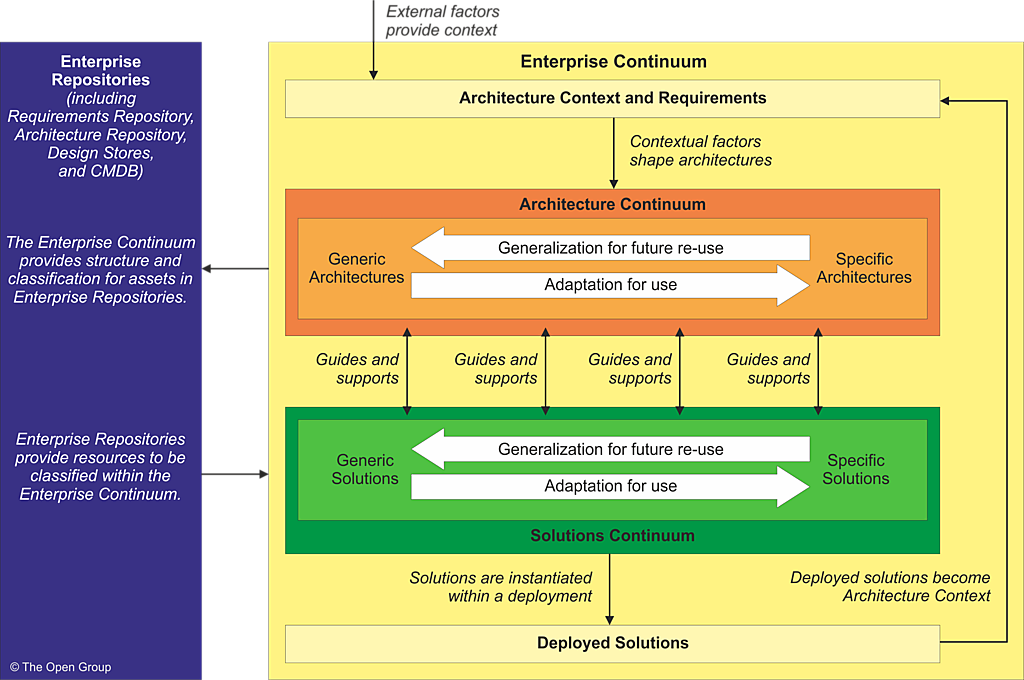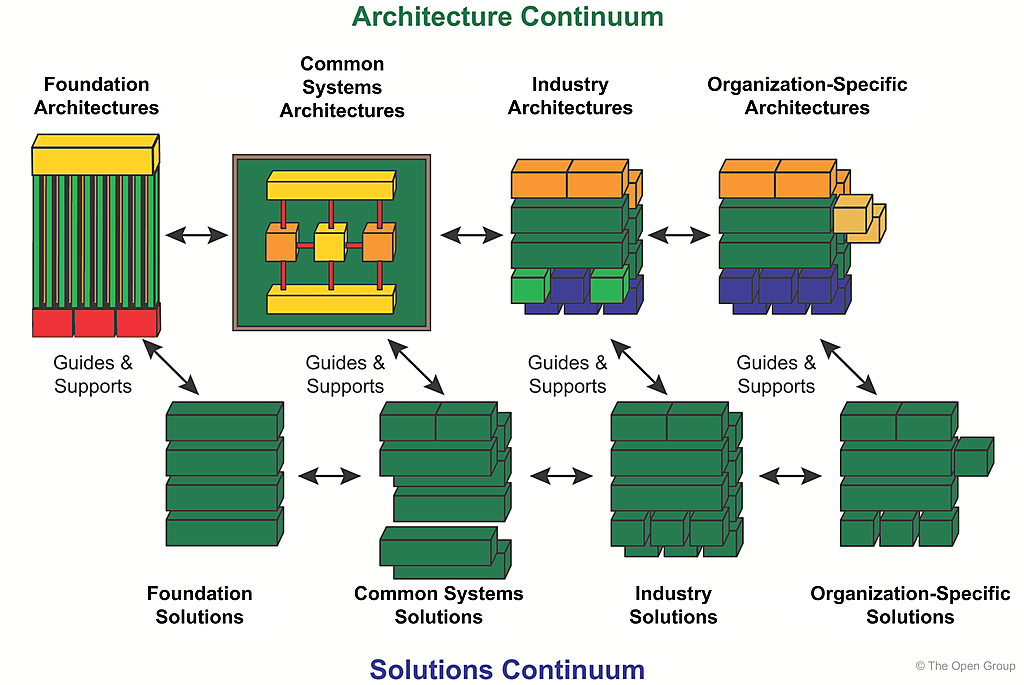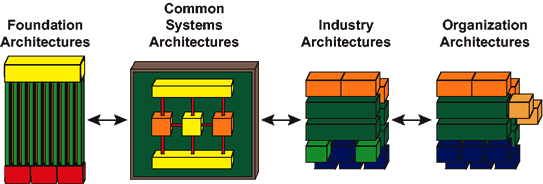What is Enterprise Continuum
Enterprise Architecture is a discipline that helps organizations align their business goals and strategies with their information technology capabilities. To achieve this, Enterprise Architects must deal with multiple related architectures, each with a different purpose, scope, and level of detail. The Enterprise Continuum is a framework that helps architects organize and classify these architectures and their artifacts.
What is Enterprise Continuum
The Enterprise Continuum is a framework used in enterprise architecture to organize and classify different types of assets that are used during the development of enterprise architectures. The Enterprise Continuum contains several classes of assets that are used to develop architectures, such as policies, standards, strategic initiatives, organizational structures, and enterprise-level capabilities. These assets are not directly used during the ADM (Architecture Development Method) architecture development process, but they may influence the architectures that are developed.
The Enterprise Continuum is a framework used in enterprise architecture to organize and classify the different levels of architecture within an organization. It provides a way to understand the evolution of the enterprise architecture from generic to specific, from abstract to concrete, and from logical to physical.
The Enterprise Continuum consists of two primary components:
- the Architecture Continuum and
- the Solutions Continuum.
The Architecture Continuum is a framework for organizing and classifying architecture artifacts, while the Solutions Continuum is a framework for organizing and classifying solutions to specific business problems.

The Architecture Continuum vs Solution Continuum
The Enterprise Continuum contains two specializations, the Architecture Continuum and the Solutions Continuum. The Architecture Continuum provides a framework for organizing and classifying architecture artifacts, while the Solutions Continuum provides a framework for organizing and classifying solutions to specific business problems. These specializations help architects to break down complex problems into manageable components and provide a clear view of the evolution of the enterprise architecture from generic to specific, from abstract to concrete, and from logical to physical.
The Architecture Continuum and Solutions Continuum are two frameworks within the Enterprise Continuum, which is part of the TOGAF (The Open Group Architecture Framework) standard.
- The Architecture Continuum is a framework that provides a structure for organizing and classifying reusable architecture assets, known as Architecture Building Blocks (ABBs). The ABBs evolve through their development lifecycle, starting as abstract and generic entities, and progressing to fully expressed Organization-Specific Architecture assets. The Architecture Continuum assets are used to guide and select elements in the Solutions Continuum.
- The Solutions Continuum, on the other hand, provides a consistent way to describe and understand the implementation of the assets defined in the Architecture Continuum. It defines what is available in the organizational environment as reusable Solution Building Blocks (SBBs). These SBBs are the solutions that are the result of agreements between customers and business partners that implement the rules and relationships defined in the architecture space. The Solutions Continuum is designed to address the commonalities and differences among the products, systems, and services of implemented systems.

In summary, the Architecture Continuum provides a framework for organizing and classifying reusable architecture assets, while the Solutions Continuum provides a framework for organizing and classifying solutions to specific business problems. Both frameworks are important components of the Enterprise Continuum and help organizations manage complexity and improve efficiency by identifying and reusing common solutions across different parts of the organization.
Example 1 – Architecture Continuum vs Solution Continuum
let’s consider an example of a large organization with multiple departments that are each responsible for managing their own IT systems. Each department may have unique needs and requirements, but there may also be commonalities and redundancies across the different systems. To manage this complexity, the organization can use the Architecture Continuum and Solutions Continuum frameworks within the TOGAF standard.
The Architecture Continuum can be used to classify and organize the reusable architecture assets across the organization, such as common system architectures, industry architectures, and enterprise architectures. For example, the organization may identify common architecture components like data models, network protocols, or application interfaces, and organize them into ABBs.
Once the Architecture Continuum is established, the organization can use the Solutions Continuum to classify and organize the solutions that are implemented within each department’s IT systems. For example, the organization may identify common solutions like customer relationship management (CRM) software, supply chain management (SCM) systems, or financial management software, and organize them into SBBs. This allows departments to reuse common solutions where possible, reducing redundancy and improving efficiency.
Overall, the Architecture Continuum and Solutions Continuum frameworks can help organizations manage complexity and improve efficiency by identifying and reusing common solutions across different parts of the organization, while still allowing for flexibility to meet department-specific needs and requirements.
Example 2 – Architecture Continuum vs Solution Continuum
Another real-life example where the Architecture Continuum and Solutions Continuum frameworks can be applied is in the development of software applications.
In software development, the Architecture Continuum can be used to classify and organize the reusable architecture assets, such as common software frameworks, design patterns, and programming languages. For example, an organization may identify common architecture components like microservices architecture, domain-driven design, or containerization, and organize them into ABBs.
Once the Architecture Continuum is established, the Solutions Continuum can be used to classify and organize the solutions that are implemented in the software applications. For example, the organization may identify common solutions like authentication and authorization, caching, or logging and error handling, and organize them into SBBs. This allows software developers to reuse common solutions where possible, reducing redundancy and improving efficiency.
Overall, the Architecture Continuum and Solutions Continuum frameworks can help software development teams manage complexity and improve efficiency by identifying and reusing common solutions across different parts of the organization, while still allowing for flexibility to meet project-specific needs and requirements.
Example 3 – Architecture Continuum vs Solution Continuum
Another real-life example where the Architecture Continuum and Solutions Continuum frameworks can be applied is in the development of a smart city infrastructure.
In a smart city infrastructure, the Architecture Continuum can be used to classify and organize the reusable architecture assets, such as common communication protocols, data models, and security frameworks. For example, the city planners may identify common architecture components like Internet of Things (IoT) networks, cloud computing platforms, or edge computing devices, and organize them into ABBs.
Once the Architecture Continuum is established, the Solutions Continuum can be used to classify and organize the solutions that are implemented in the smart city infrastructure. For example, the city planners may identify common solutions like smart lighting systems, intelligent transportation systems, or waste management systems, and organize them into SBBs. This allows the city to reuse common solutions where possible, reducing redundancy and improving efficiency.
Overall, the Architecture Continuum and Solutions Continuum frameworks can help city planners manage complexity and improve efficiency by identifying and reusing common solutions across different parts of the infrastructure, while still allowing for flexibility to meet city-specific needs and requirements.
A Real-Life Example of Documenting ABBs and SBBs
here is an example of how the Architecture Continuum and Solutions Continuum frameworks could be applied in the context of a smart city infrastructure:
Architecture Building Blocks (ABBs)
- IoT Network Architecture – defines the architecture components required for the deployment and management of an IoT network, including gateways, sensors, and edge devices.
- Cloud Computing Platform – defines the architecture components required for the deployment and management of a cloud computing platform, including virtual machines, storage, and networking.
- Security Framework – defines the architecture components required for the deployment and management of a secure smart city infrastructure, including authentication, authorization, and encryption.
Solutions Building Blocks (SBBs)
- Smart Lighting System – a solution that uses IoT sensors and cloud computing to control the lighting in public spaces, reducing energy consumption and improving safety.
- Intelligent Transportation System – a solution that uses IoT sensors and cloud computing to optimize traffic flow, reduce congestion, and improve public transportation services.
- Waste Management System – a solution that uses IoT sensors and cloud computing to optimize waste collection and disposal, reducing environmental impact and improving public health.
By using the Architecture Continuum to classify and organize the ABBs, and the Solutions Continuum to classify and organize the SBBs, the city planners can improve the efficiency and effectiveness of their smart city infrastructure projects. By reusing common ABBs and SBBs across different parts of the infrastructure, they can reduce redundancy and improve consistency, while still allowing for flexibility to meet specific project needs and requirements.
Types of Documents Included in The Architecture Continuum
Here’s an example of what types of documents might be included in each of the four levels of the Architecture Continuum:

- Foundational Architecture – this level includes foundational frameworks and models that provide a common basis for all architectures within an organization. Example documents might include:
- TOGAF Framework
- Business Capability Model
- Data Architecture Principles
- Common Systems Architecture – this level includes architectures for specific types of systems that are used across multiple parts of the organization. Example documents might include:
- Service-Oriented Architecture (SOA)
- Information Technology Infrastructure Library (ITIL)
- Data Center Architecture
- Industry Architecture – this level includes architectures that are specific to a particular industry or sector. Example documents might include:
- Health Information Exchange (HIE) Architecture
- Financial Services Architecture Framework (FSAM)
- Defense Information Infrastructure (DII) Architecture
- Enterprise Architecture – this level includes the architectures that are specific to the enterprise itself. Example documents might include:
- Enterprise Data Architecture
- Enterprise Application Architecture
- Enterprise Security Architecture
The specific types of documents included in each level may vary depending on the organization and its needs, but this example should give you an idea of the types of documents that might be included.
Types of Documents Included in The Solution Continuum

here’s an example of what types of documents might be included in each of the four levels of the Solutions Continuum, related to the proposed ABBs of the Architecture Continuum:
- Foundational Solutions – this level includes generic solutions that can be used across multiple parts of the organization. Example documents might include:
- Enterprise Service Bus (ESB)
- Data Warehouse Solution
- Identity and Access Management (IAM) Solution
- Common Systems Solutions – this level includes solutions for specific types of systems that are used across multiple parts of the organization. Example documents might include:
- Human Resource Information System (HRIS) Solution
- Customer Relationship Management (CRM) Solution
- Enterprise Resource Planning (ERP) Solution
- Industry Solutions – this level includes solutions that are specific to a particular industry or sector. Example documents might include:
- Electronic Medical Record (EMR) Solution
- Trading Platform Solution
- Logistics Management Solution
- Enterprise Solutions – this level includes solutions that are specific to the enterprise itself. Example documents might include:
- Sales Order Processing Solution
- Accounts Payable Solution
- Manufacturing Execution System (MES) Solution
Again, the specific types of documents included in each level may vary depending on the organization and its needs, but this example should give you an idea of the types of documents that might be included in each level of the Solutions Continuum, related to the proposed ABBs of the Architecture Continuum.
Summary
The article discusses the concept of Enterprise Continuum in the context of enterprise architecture. It explains how the Enterprise Continuum provides a view of the Architecture Repository that shows the evolution of related architectures from generic to specific, abstract to concrete, and logical to physical. The article also introduces the Architecture Continuum and Solutions Continuum, which are two specializations of the Enterprise Continuum.
The Architecture Continuum represents a structuring of Architecture Building Blocks (ABBs), while the Solutions Continuum provides a consistent way to describe and understand the implementation of the assets defined in the Architecture Continuum. The article provides examples of documents that might be included in each of the four levels of the Architecture Continuum and Solutions Continuum. Overall, the article emphasizes the importance of effective scoping of enterprise architectures and the use of architecture assets to guide and select the elements in the Solutions Continuum.

